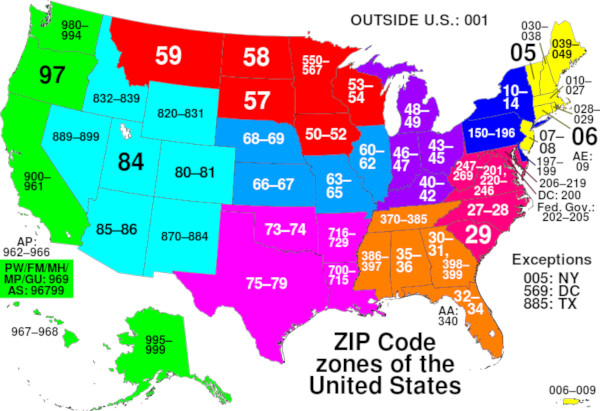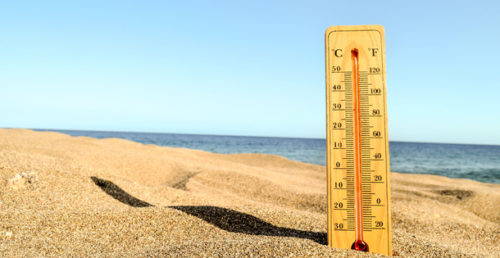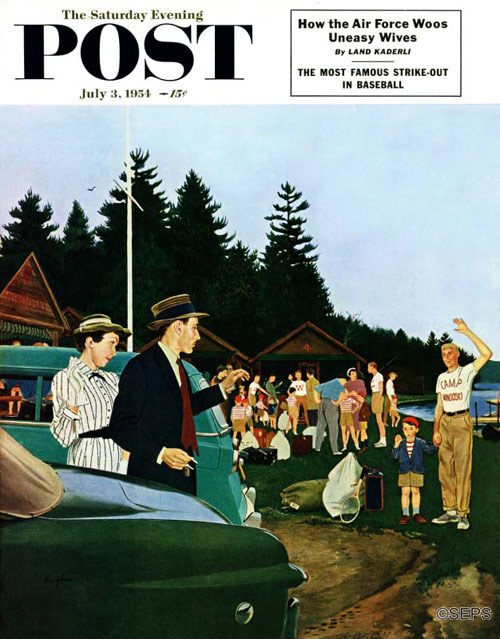July 1 through History: A Day of Rules and Measures
With a limited number of days on the calendar, many events across the broad spectrum of history happen to share a date. Sometimes the pairings are fraught with irony, like when John Adams and Thomas Jefferson died on the same day … which happened to be the Fourth of July. Other times they’re interesting coincidences, such as all of the meaningful events that happened on April 30 over the decades.
July 1st might not be the “biggest” day in history, but it happened to be the landing zone for events that affect your everyday life. In 1959, 1963, and 1984, the first day of July saw changes to numbers and rules that have a bearing on how you measure, how you mail, and how you go to the movies.
July 1, 1959: The Agreement on International Measurements

The definitions for weights and measures typically come from a physical object called a standard. A standard for one pound, for example, would weigh one pound. Disaster struck in 1834 when the Palace of Westminster in England, the home of British Parliament, burned; among the things destroyed by the blaze were the physical standards for weight and length. New versions were made, and in 1855, the
United States adopted that new British ruler for feet and yards.
The next several decades saw updates and additions that were generally agreed upon by the United States, England, and other countries associated with the British Commonwealth. By 1903, American physicist Albert Michelson’s experiments in electromagnetic waves proved that you could set defined lengths using light waves. Over the next few years, the International Bureau of Weights and Measures would accept the light-wave definition of the meter; by 1935, 16 countries had taken on the light-wave inch (25.4 mm) as the “industrial inch” standard.
Things got even more precise as scientists and standards bodies from around the world began to consider atomic measurements. The U.S., the U.K., Australia, Canada, New Zealand, and South Africa agreed upon a specific “international pound” and “international yard” in 1958. The new definitions placed the 3-foot yard as equivalent to .9144 meters, and the pound at .45359237 kilograms. On July 1, 1959, the U.S. National Bureau of Standards (now the National Institute of Standards and Technology) officially approved the system.
Today, only three countries have not adopted the metric system for everyday use: Liberia, Burma, and the United States. The other 192 countries on Earth use it for everything. However, the U.S. does commonly use the metric system in the fields of science, medicine, and a number of other industries (including firearms manufacturing, gemstones, and energy).
July 1, 1963: ZIP Codes Come to America

Introduced on this date in 1963 with the hope of improving mail delivery speed and efficiency, the ZIP (Zone Improvement Plan) code was the brainchild of postal inspector Robert Moon; he proposed a three-digit postal code in 1944. The first digit represents your region of the country (0 is the East Coast, 9 the West Coast), and digits two and three stand for an SCF or “sectional center facility”; that’s the place where mail is sorted for a certain area. The Postal Service added the final two digits to the code to provide more specificity, routing the mail to the proper post office for delivery. A second big change came to the mail on October 1 of that year, when the two-letter state abbreviations were introduced.
ZIP codes got an upgrade in 1983 when the “ZIP+4” debuted. The extra four digits are intended to get very specific, sometimes representing a single building within the area defined by the first five digits. The most famous ZIP code in the United States is likely 90210, the code for Beverly Hills; BH90210, the third TV series to bear the well-known numbers, begins on August 7 on Fox.
July 1, 1984: The MPAA Releases PG-13
The infamous Gremlins kitchen scene (Uploaded to YouTube by Movieclips)
Blame it on the Gremlins; well, Gremlins and Indiana Jones. The Motion Picture Association of America introduced the modern film ratings system in 1968; after a couple of years of tinkering, the system settled on G (General Audiences), PG (Parent Guidance suggested), R (Restricted, no one under 17 admitted without a parent or guardian), and X (no one under 17). In 1984, however, two Steven Spielberg-related films pushed the envelope on violence at the cinema. The Spielberg-directed Indiana Jones and the Temple of Doom showed a beating heart being removed from a man’s chest, while the Spielberg-produced Gremlins featured a number of gross-outs, including the famous kitchen massacre scene. Complaints and controversy arose over the two PG films, and the MPAA’s solution was to introduce a new rating as a middle ground between PG and R. The PG-13 rating represents the idea of “Parents Strongly Cautioned,” meaning that there is likely to be more violence, swearing, or limited nudity than one would expect in a PG film. The first movie to carry the rating was John Milius’s Brat-Pack-vs.-the-Soviet-Union actioner Red Dawn.
Featured image: Shutterstock
News of the Week: Heat Wave! Meteorites! Coffee Is Good for You (Again)!
Stop Saying “It’s Not the Heat, It’s the Humidity”

(This is another rant about the weather. If you don’t want to read it, you can scroll down to where I talk about meteorites and zip codes.)
All I want to do is sit in front of a fan and eat Popsicles.
This heat wave has been supernaturally unbearable. Several days of temps at 90 or above and dew points near 70. (The old saying is wrong, it’s both the heat and the humidity.) That’s not even air, that’s soup. And I don’t mean a thin broth; it’s more like walking through a Chunky soup that eats like a meal. I went to the supermarket the other day and the parking lot was like a giant cookie sheet in an oven. It has gotten to the point where I can’t even watch news reports about the weather because they all show people sitting in the hot sun or, worse yet, wearing suits and walking around. It makes me uncomfortable.
I hope it’s better where you are, but if you live in a part of the country that’s affected by the high temps and humidity, don’t overdo any activity, drink lots of water, check on your pets, and try to stay in a place where there’s air conditioning. We’re supposed to get a short reprieve this weekend, but then early next week it’s back into the nastiness. It’s like living on the sun.
I’m thinking about going to the liquor store tonight. Not for liquid refreshment; I’m going to ask if I can live in their walk-in cooler until Labor Day.
Watch This

There was a lot of space news this past week, from a story that explains how the wreckage of just five or six planets created the asteroid belt, to NASA releasing this terrific new photo of Jupiter. But the most fun news is that the space agency is looking for a meteorite, and you can watch them do it.
On March 7, a large meteorite broke apart above the Earth and fell into the Pacific Ocean. It weighed two tons, and the pieces are probably 330 feet down, but NASA wants to retrieve them for study. You can watch a livestream of the search conducted by the Nautilus here and read about the preliminary findings of the expedition here.
Chestnut and Hot Dogs
Joey Chestnut broke his own record at Nathan’s Hot Dog Eating Contest on July 4. He ate 74 hot dogs (with buns!) in 10 minutes. It’s a new world record and the 11th time in 12 years that Chestnut has won. Miki Sudo won the women’s division by eating 37. The “sport” is now televised live on ESPN, like basketball and tennis. I still don’t understand how it’s physically possible to eat 74 hot dogs and buns in just 10 minutes. Forget about LeBron or Federer, Chestnut is the ultimate athlete.
I’ve said this before but I still want to know: Is there someone out there named Joey Hot Dog, and every year he enters a chestnut-eating contest?
WWII Vet Has All of His Money Stolen
This is a rather depressing story, but it has a happy ending.
Richard Overton, a World War II veteran and, at 112 years old, the oldest man in America, recently had his bank account wiped out by scammers. Thieves got hold of his account information and Social Security number and used them to buy savings bonds.
The story has a happy ending, though. Overton’s bank replaced the funds that were taken from his account.
One side note to this story: Overton reached the age of 112 despite his habit of smoking 12 cigars a day, enjoying alcohol, and drinking a ton of coffee.
Java, Dirt, Joe, Mud, Jitter Juice

Maybe Overton is on to something.
Researchers in the United Kingdom studied over 500,000 people between the ages of 38 and 73 to see how the consumption of coffee affected their health. Turns out the benefits of coffee outweigh any risks.
I wouldn’t get too excited, though. If you like coffee and you don’t have a medical condition that prevents you from drinking it, then fine, keep drinking it. I know people who drink four, six, eight cups a day. Just be aware that in approximately seven weeks there are going to be news reports touting a study that says drinking coffee causes iguanas to grow a fifth leg or something similar. Though the often-talked-about cancer risk doesn’t seem to be as big a problem as once thought, as Dr. Zipes explains.
In related news, here’s a bunch of great vintage coffee ads from the Post.
RIP Stanley Anderson, Gillian Lynne, and Derrick O’Connor
Stanley Anderson appeared in such movies as Spider-Man and Armageddon and TV shows like L.A. Law, The Drew Carey Show, and Seinfeld (he played the judge in the finale). He also did a lot of voiceover work for political ads. He died Sunday at the age of 78.
Gillian Lynne started out as a dancer and went on to be the choreographer for such classic Andrew Lloyd Webber productions as Cats and The Phantom of the Opera. She died Sunday at the age of 92.
You’ll remember Derrick O’Connor as the evil henchman in Lethal Weapon 2. He also had roles in movies like Daredevil and Hope and Glory and many TV shows, including Alias, Stringer, and Murder, She Wrote. He died last Friday at the age of 77.
Quote of the Week
“The two most common elements in the universe are hydrogen and stupidity.”
—Harlan Ellison, in a line that has been making the rounds again since his death last week. Here are some more memorable quotes from the acclaimed writer.
This Week in History
Zip Code Debuts (July 1, 1963)
I don’t remember a world before zip codes existed, so the history of how they came about is fascinating to me. CBS Sunday Morning did a story about it this week for the 55th anniversary. I want one of those cardboard Mr. Zip figures.
Nick at Nite Launches (July 1, 1985)
Can someone explain to me how a channel that has always been devoted to classic TV shows like The Donna Reed Show, The Adventures of Superman, and The Mary Tyler Moore Show can now run disgusting tripe like Two and a Half Men and Mom?
Luckily we still have MeTV, Cozi, and Antenna TV.
This Week in Saturday Evening Post History: First Day at Camp (July 3, 1954)

George Hughes
July 3, 1954
I never went to camp when I was a kid. I sometimes wonder if I missed out on something, but then I remember that camp involves all of the things I hate about summer, and I realize I lucked out that my mom never sent me to one. I do like this George Hughes cover, though.
Saturday Is World Chocolate Day

Every day is World Chocolate Day, really, but maybe you can celebrate the day by trying a chocolate you’ve never tried before. I was always a milk chocolate person — and for the most part I still am — but I love a Dove or Ghirardelli dark chocolate once in a while, too. Though I have to admit that I usually go for something that has a pretty high cocoa content, like 60 or 72 percent.
Some recipes: Here’s a Deep Dark Chocolate Cake from the Hershey Make It Chocolate! cookbook; here’s a Quick Creamy Chocolate Pudding, also from Hershey; and here’s a recipe for a Chocolate Milkshake from Betty Crocker.
A suggestion: With this heat, I’d go for the milkshake. You won’t have to turn on your oven.
Next Week’s Holidays and Events
Friday the 13th (July 13)
This is the second and last time we’ll have a Friday the 13th in 2018. If you’re planning your 2019 schedule, the date will show up twice then, too.